
Oct 30
/
Alef Dias
Grains, Oilseeds and Livestock Weekly Report - 2023 10 30
Back to main blog page
- The southern hemisphere harvests are approaching their conclusion, and this is arousing growing interest in the market, especially due to the unfavorable weather conditions in Argentina and Australia. Even after the recent adjustments made by the USDA to its estimates for both countries, there is still room for possible further reductions.
- However, in the northern hemisphere, initial information for the 24/25 harvest points to another year of solid winter production in the region's main producing countries. This is largely due to the increase in the planted area in the Black Sea countries and the expectation of better yields and less area abandonment in the US.
- As a result, wheat markets are likely to have a tighter first half of 2024 and more relief in the second half of the year.
Wheat: Different signs in the northern and southern hemispheres
Introduction
The southern hemisphere harvests are heading towards their final stages, and with that they continue to attract more and more attention from the market participants - mainly due to the fact that the weather continues to be adverse in both Argentina and Australia.
However, in the northern hemisphere, the first data for the 24/25 harvest is pointing to another year of good winter production in the main producing countries. This report will provide an update on the harvests in both regions and how these factors should affect prices and the global supply and demand balance.
As harvest of spring crops in the Northern Hemisphere advances, our focus turns even more to Southern Hemisphere, as crops in Argentina and Australia enter their critical development months.
Even with the severe decline in Australia’s output due to the El Niño and the “not-so-great” recovery of Argentina’s crop, these countries still rank among the top exporters and combined they will be responsible for around 15% of global exports according to USDA’s current estimates.
Consequently, impacts on their crops remain relevant to the world’s wheat supply and demand balance, so this report aims to discuss the recent developments in Argentina’s and Australia’s crop
Argentina: rains arrived too late
Argentina - the second largest producer and exporter in the southern hemisphere - has been facing very similar weather conditions to last year's crop, which was a historic crop failure for the country. The main producing regions have received rains in recent days, and forecasts point to a continuation of these rains in November).
However, around 7% of Argentina's wheat is already harvested, so these rains probably came too late to change the outlook for the crop. The Rosario Stock Exchange is already working with a production estimate of 14.3M mt - around 2M mt less than the USDA's current estimate.
Fig. 1: Wheat Good and Excellent conditions – Argentina Wheat (%)
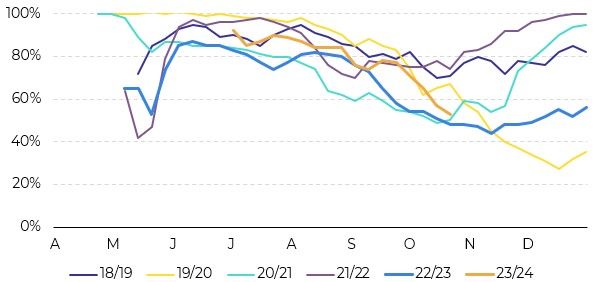
Source: Bolsa de Cereales
Australia: more room for recovery, but forecasts are gloomy
As expected due to El Niño, the Australian crop continues to face extremely hot and dry weather compared to the historical average, which should have a significant impact on wheat yields in the country. Compared to Argentina, Australia has a slightly later harvest, as Australian producers usually start harvesting their wheat in December. Consequently, the country's crop still has more room to recover.
However, the weather forecast for November does not point in this direction, as practically the entire country is not expected to receive much rainfall next month. The USDA's current estimate - of 24.5M mt - is already a very negative scenario, but the yields seen in other recent failures show that there is still room for reductions in estimates.
Fig 2: Precipitation Anomaly – Australia - Nov-23 (mm/day from normal)
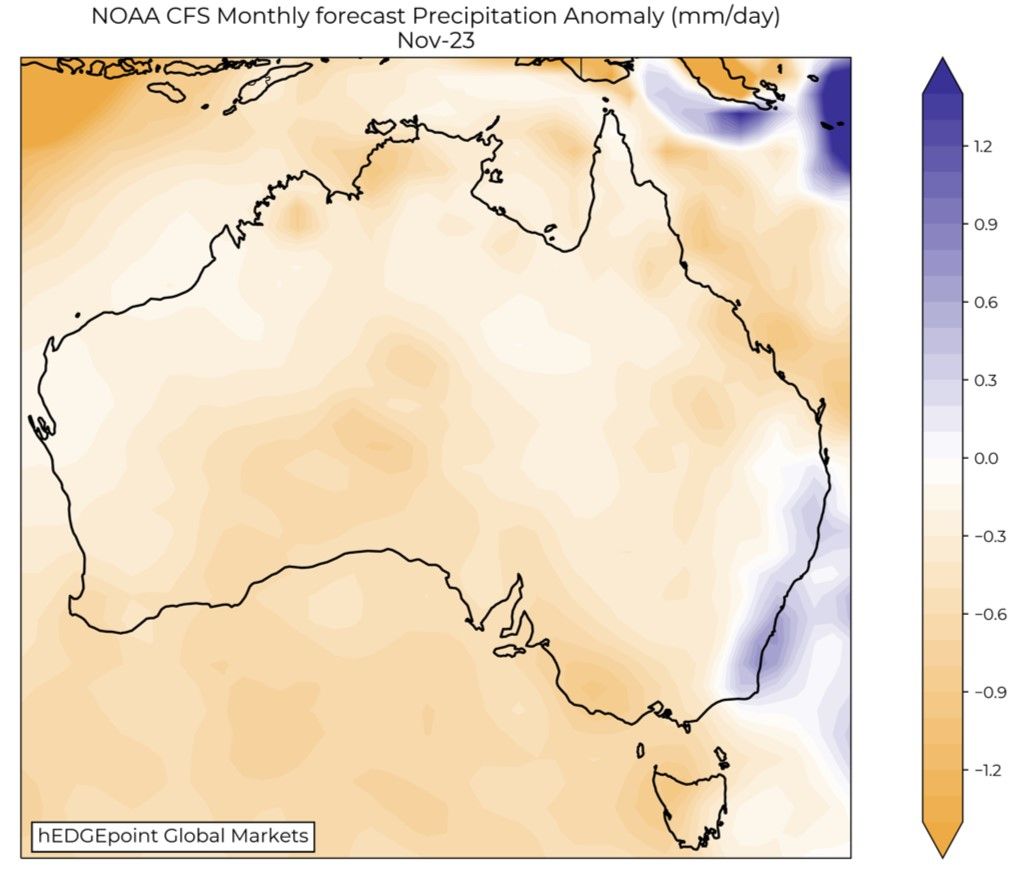
Source: hEDGEpoint, NOAA
Northern hemisphere: soil moisture is a concern, but area and climate can offset it
In the northern hemisphere, the 24/25 crop is being planted and some relevant data is already available. Looking at the main Black Sea producers and exporters - Russia and Ukraine - the planted area data so far points to an increase in area compared to last season.
This move is very surprising given the lower level of wheat prices, the challenges posed by the war (mainly on the Ukrainian side), and the high stocks in Russia due to the country's last two excellent crops. On the other hand, soil moisture is at its lowest level in recent years in the main producing regions of both countries, which could lead to lower yields.
Looking at the November rainfall forecasts, a change in this situation can be expected in Ukraine, while the main producing regions in Russia should continue to face drier weather. With regard to temperature forecasts for the dormant period, the risk of winter kill seems low at the moment.
Fig. 3: Winter Wheat Planting Progress - Russia (M ha)
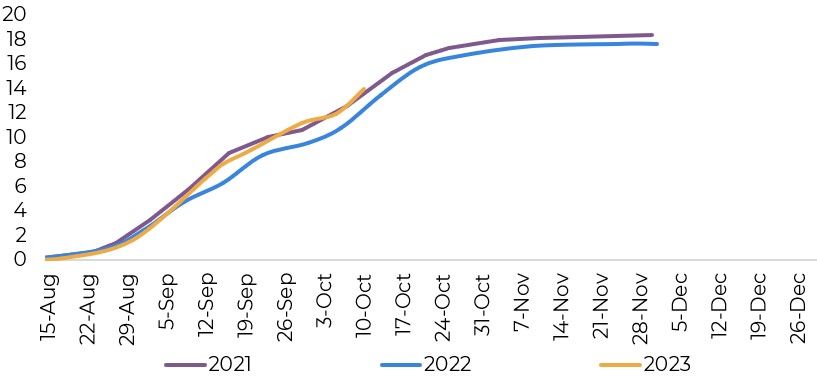
Source: : Russian Agriculture Ministry
In the US, however, the situation is practically the opposite. After a record planted area in the last season, American producers are likely to plant less winter wheat, given that the drop in prices this year has been much greater than the drop in costs. However, the weather so far has been more favorable. Soil moisture is above 2022 levels and drought conditions are not as severe as last year. Forecasts for the month of November bring a mixed picture for the main producing states - more rainfall in Texas and Oklahoma, while the weather is expected to remain dry in Kansas.
As a result, a good crop is expected in the US so far, which could even surpass that of 23/24 if area abandonment returns to the average and yields remain around the trend.
Fig 4: Plains Daily Root Zone Soil Moisture (% in the 1st meter)
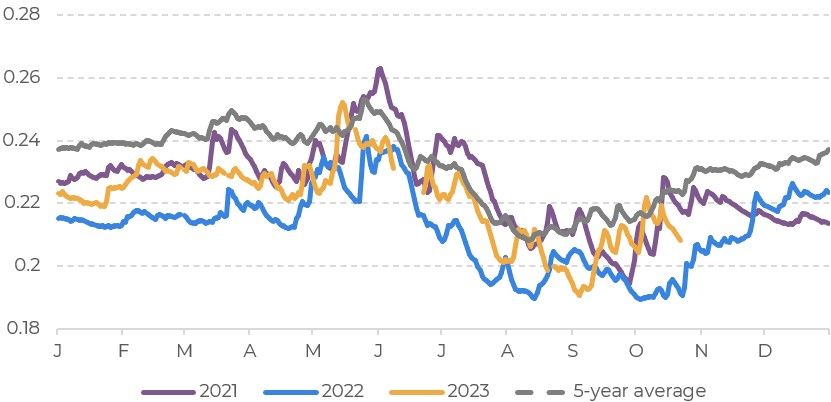
Source: Refinitiv
Fig 5: Production and Harvested Acres Winter Wheat - US (Bi bu, M ac)
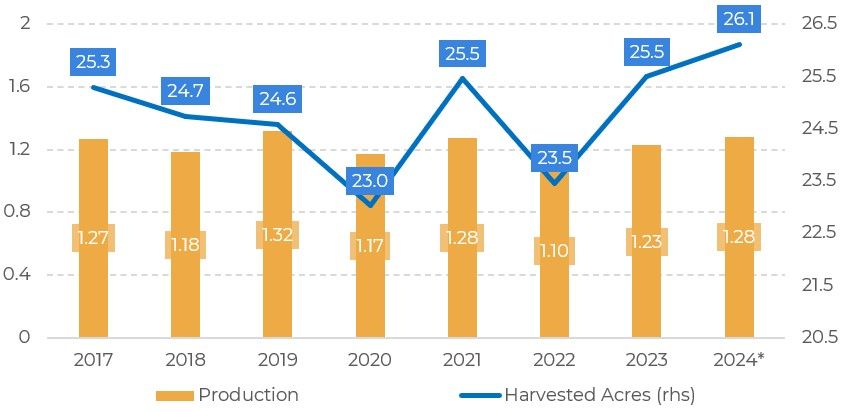
Source: USDA, Refinitiv, hEDGEpoint
Conclusion
The southern hemisphere harvests are coming to a close, and this has drawn increasing attention from the market, mainly due to the unfavorable weather conditions in Argentina and Australia. Despite the latest adjustments made by the USDA to the estimates for both countries, there is still room for further cuts.
Meanwhile, in the northern hemisphere, initial data for the 24/25 harvest indicates another year of good winter production in the region's main producing countries, largely due to the larger area planted in the Black Sea countries and the expectation of better yields and less area abandoned in the US. As a result, the wheat markets are likely to have a tighter first half of 2024 and more relief in the second half of the year.
Weekly Report — Grains and Oilseeds
Written by Alef Dias
alef.dias@hedgepointglobal.com
alef.dias@hedgepointglobal.com
Reviewed by Pedro Schichi
pedro.schichi@hedgepointglobal.com
pedro.schichi@hedgepointglobal.com
www.hedgepointglobal.com
Disclaimer
This document has been prepared by hEDGEpoint Global Markets LLC and its affiliates ("HPGM") exclusively for informational and instructional purposes, without the purpose of creating obligations or commitments with third parties, and is not intended to promote an offer, or solicitation of an offer, to sell or buy any securities or investment products. HPGM and its associates expressly disclaim any use of the information contained herein that may result in direct or indirect damage of any kind. If you have any questions that are not resolved in the first instance of contact with the client (client.services@hedgepointglobal.com), please contact our internal ombudsman channel (ouvidoria@hedgepointglobal.com) or 0800-878-8408 (for clients in Brazil only).
Contact us
hedgepointhub.support@hedgepointglobal.com
ouvidoria@hedgepointglobal.com
Funchal Street, 418, 18º floor - Vila Olímpia São Paulo, SP, Brasil
Check our general terms and important notices.
This page has been prepared by Hedgepoint Schweiz AG and its affiliates (“Hedgepoint”) solely for informational and instructional purposes, without the purpose of instituting obligations or commitments to third parties, nor is it intended to promote an offer, or solicitation of an offer of sale or purchase relating to any securities, commodities interests or investment products. Hedgepoint and its associates expressly disclaim any use of the information contained herein that directly or indirectly result in damages or damages of any kind. Information is obtained from sources which we believe to be reliable, but we do not warrant or guarantee the timeliness or accuracy of this information. The trading of commodities interests such as futures, options, and swaps involves substantial risk of loss and may not be suitable for all investors. You should carefully consider wither such trading is suitable for you in light of your financial condition. Past performance is not necessarily indicative of future results. Customers should rely on their own independent judgement and/or advisors before entering in any transaction.Hedgepoint does not provide legal, tax or accounting advice and you are responsible for seeking any such advice separately.Hedgepoint Schweiz AG is organized, incorporated, and existing under the laws of Switzerland, is filiated to ARIF, the Association Romande des Intermédiaires Financiers, which is a FINMA-authorized Self-Regulatory Organization. Hedgepoint Commodities LLC is organized, incorporated, and existing under the laws of the USA, and is authorized and regulated by the Commodity Futures Trading Commission (CFTC) and a member of the National Futures Association (NFA) to act as an Introducing Broker and Commodity Trading Advisor. HedgePoint Global Markets Limited is Regulated by the Dubai Financial Services Authority. The content is directed at Professional Clients and not Retail Clients. Hedgepoint Global Markets PTE. Ltd is organized, incorporated, and existing under the laws of Singapore, exempted from obtaining a financial services license as per the Second Schedule of the Securities and Futures (Licensing and Conduct of Business) Act, by the Monetary Authority of Singapore (MAS). Hedgepoint Global Markets DTVM Ltda. is authorized and regulated in Brazil by the Central Bank of Brazil (BCB) and the Brazilian Securities Commission (CVM). Hedgepoint Serviços Ltda. is organized, incorporated, and existing under the laws of Brazil. Hedgepoint Global Markets S.A. is organized, incorporated, and existing under the laws of Uruguay. In case of questions not resolved by the first instance of customer contact (client.services@Hedgepointglobal.com), please contact internal ombudsman channel (ombudsman@hedgepointglobal.com – global or ouvidoria@hedgepointglobal.com – Brazil only) or call 0800-8788408 (Brazil only).Integrity, ethics, and transparency are values that guide our culture. To further strengthen our practices, Hedgepoint has a whistleblower channel for employees and third-parties by e-mail ethicline@hedgepointglobal.com or forms Ethic Line – Hedgepoint Global Markets.Security note: All contacts with customers and partners are conducted exclusively through our domain @hedgepointglobal.com. Do not accept any information, bills, statements or requests from different domains and pay special attention to any variations in letters or spelling, as they may indicate a fraudulent situation.“HedgePoint” and the “HedgePoint” logo are marks for the exclusive use of HedgePoint and/or its affiliates. Use or reproduction is prohibited, unless expressly authorized by HedgePoint. Furthermore, the use of any other marks in this document has been authorized for identification purposes only. It does not, therefore, imply any rights of HedgePoint in these marks or imply endorsement, association or seal by the owners of these marks with HedgePoint or its affiliates.

